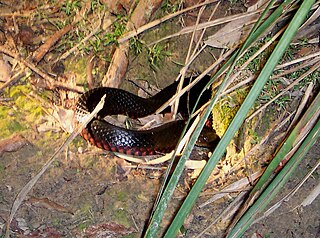
Spilotes pullatus, commonly known as the chicken snake, tropical chicken snake, or yellow rat snake, is a species of large nonvenomous colubrid snake endemic to the Neotropics.

Spilotes sulphureus, commonly known as the yellow-bellied hissing snake or Amazon puffing snake, is a species of snake in the family Colubridae. The species is found in South America, as well as the Caribbean island of Trinidad.

Phrynonax poecilonotus is a species of nonvenomous snake in the family Colubridae. The species is endemic to the New World.
Erythrolamprus ocellatus, commonly known as the Tobago false coral snake, red snake, or doctor snake is a species of colubrid snake, which is endemic to the island of Tobago.

Podocnemis is a genus of aquatic turtles, commonly known as South American river turtles, in the family Podocnemididae. The genus consists of six extant species occurring in tropical South America. Three additional species are known only from fossils.
Philodryas is a genus of colubrid snakes endemic to South America, commonly called green snakes.

Dasypeltis is a genus of colubrid snakes. It is one of only two taxonomic groups of snakes known to have adapted to feed exclusively on eggs. Dasypeltis are non-venomous and found throughout the continent of Africa, primarily in forested or wooded habitats that are also home to numerous species of birds.

Pseudechis is a genus of venomous snakes in the family Elapidae. It contains the group of elapid species commonly referred to as the black snakes. Species of Pseudechis are found in every Australian state with the exception of Tasmania, and some species are found in Papua New Guinea. They inhabit a variety of habitat types, from arid areas to swampland. All species are dangerous and can inflict a potentially lethal bite. Most snakes in this genus reach about 2 m (6.6 ft) in total length, and vary in colour. Some species are brown, whereas others are black. The most recognisable and widespread species in the genus are the red-bellied black snake and the mulga snake. These snakes feed on lizards, frogs, birds, small mammals, and even other snakes. All species of Pseudechis lay eggs with the exception of the red-bellied black snake P. porphyriacus which is viviparous. The genus Pailsus is a synonym of Pseudechis, and more work is needed to understand species limits among the smaller species of the group.

Oxybelis is a genus of colubrid snakes, endemic to the Americas, which are commonly known as vine snakes. Though similar in appearance to the Asian species of vine snakes of the genus Ahaetulla, they are not closely related, and are an example of convergent evolution.

Telescopus, the Old World catsnakes, is a genus of 12 species of mildly venomous opisthoglyphous snakes in the family Colubridae.

Hoplocephalus is a genus of venomous snakes in the family Elapidae. The genus is endemic to Australia. Three species are recognized.
Hydrops is a genus of snakes in the subfamily Dipsadinae of the family Colubridae. The genus is endemic to South America.

Geophis is a genus of snakes in the subfamily Dipsadinae of the family Colubridae of the superfamily Colubroidea. Species in the genus Geophis are commonly referred to as Latin American earth snakes. The genus consists of 53 distinct species.

Oxyrhopus, the false coral snakes, is a genus of colubrid snakes that belong to the subfamily Dipsadinae. The genus is found in Central America and the northern part of South America, and it includes 15 distinct species.

Scaphiophis is a genus of African snakes in the family Colubridae. Common names include hook-nosed snakes and shovel-nosed snakes.

Xenopholis is a genus of rear-fanged snakes of the family Colubridae.

Rhinobothryum is a genus of snakes in the family Colubridae.

Pseustes was a genus of snakes of the family Colubridae.
Hydromorphus is a genus of snakes in the subfamily Dipsadinae.
Geophis championi, the Panamenian earth snake, is a species of snake in the family Colubridae. The species is endemic to Panama.














